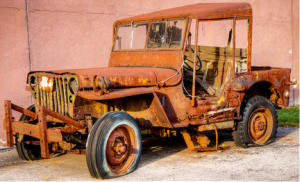Guest post by Michael Grayen
My Jeep body needs extensive rust repair and straightening. Is there an easier way to bring it back to perfection?
When it comes to automotive restoration, experts in the field say you’ll have better luck and spend the least amount of money when you start by finding the best example of the year and model you’re interested in. Sound advice – however, finding a high-quality Jeep CJ in original condition is not so easy to do. High-quality originals in stock condition are rare, and ones that are command extremely high prices due to the widespread, fanatical fan base. Jeep enthusiasts themselves uniformly agree it’s harder than ever these days to find one that hasn’t rusted into powder, been chopped and modified, or been beat on badly off-roading.

If your Jeep restoration is at this stage, there’s no better time to invest in Mopar-licensed reproduction Jeep body tubs and body panels made of 16- and 18-gauge steel. (photo credit: VirtualJeepClub.com)

Classic Jeeps still in original condition are out there, but usually require a great deal of bodywork. (photo credit: eWillys.com)
And what if the only Jeep that matters is the one you already own? Perhaps yours is one that you’ve had personal history with that can’t be bought at any price. Restoring a Jeep is a labor of love — hard labor at times. Taking things apart, sourcing replacement parts, rebuilding mechanical items, test fitting, disassembling, painting, then reassembling again is daunting enough without performing extensive bodywork.

Omix-ADA steel body tubs are shipped pre-assembled, and can be ordered with or without front fenders, hood, windshield, and tailgates. (photo credit: Omix-ADA)
While mechanical disassembly and reassembly can be learned as you go, bodywork processes that involve cutting, welding, filling holes, smoothing surfaces, and painting are best left to experts if you want the best results. We’ve created this article to help the Jeep enthusiast facing substantial body issues find an easier way to bring their rig back to perfection again.
Looking across various Jeep forums, there are many accounts of hidden rust discoveries that were far worse than expected. Some express distress when seeing the full extent of how panels were chopped to provide clearance, and realizing that numerous body panels may never line up again after the vehicle was off-roaded hard. For those realizing they’re beyond minor body work, Jeep specialist Omix-ADA manufactures new steel replacement body tubs for Jeep CJs that are officially recognized by the factory as official restoration parts.
FCA has determined that these are such accurate reproductions of the original that they allow trademarked “Jeep” or “Willys” logos to be stamped into the fender panels. Their seal of approval comes in the form of a “Mopar Official Licensed Product” branding that you won’t find elsewhere.
Unlike fiberglass CJ body shells that can be flimsy and hurt the value of your restored vehicle, Omix-ADA bodies are crafted from thick 16- and 18-gauge steel that more accurately represents the strength and durability the original engineers had in mind. Body tubs are shipped pre-assembled, and can be ordered with or without front fenders, hood, grille, and tailgate.
Body tubs will include rear fenders, rear wheel housings, a front cowl panel, dash panel, and glove box. These separate components have been fitted, aligned, then welded in place. According to the Jeep owners who have installed them, areas of the body line up in perfect harmony to factory mounting spots. Tubs or individual panels go on easily without modification and line up nice and straight once installed.
Omix-ADA body tubs and body parts are treated with a process that’s far more extensive than original parts were at the factory. First, the metal is submerged in five separate tanks of chemical cleaners to strip any foreign contaminants. After the metal is brought to as pure a state as possible, phosphate and acid rinses add the corrosion protection layer and provide a surface for superior paint bonding.
If you’re facing serious body work to save your beloved CJ, consider going with Omix-ADA body panels or an entire tub to do it right and do it once, with the best possible results.
Michael Grayen is a technical writer at CARiD.com and a Jeep nut.


